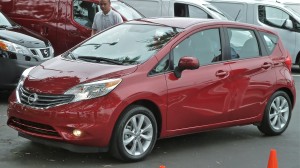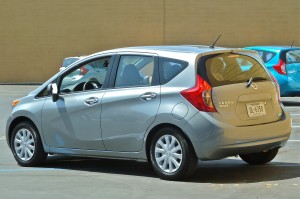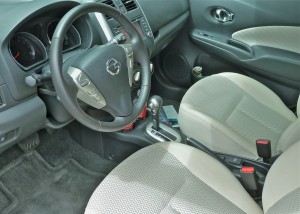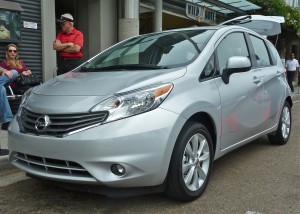Nissan Versa hits high Note
By John Gilbert
Nissan is expanding its popular Versa subcompact line by adding a new Note, with a more versatile wagon-like shape to take on top segment competitors. Combining the Sentra and the Sentra Note, it would appear Nissan has the subcompact segment covered, chapter and Versa. To coin a phrase.
The Nissan Versa is like a successful singer in the choir of subcompacts, able to carry a tune but preferring to blend into the harmony than to stand out as a solo act. Maybe that subtlety has helped the Versa lead the segment in sales, but its new member appears much more eager to grab the spotlight and hit all the high notes.
Honda has its versatile subcompact with the Honda Fit, competing with the Versa sedan, and Nissan doesn’t apologize for going after the Fit’s versatility with the wagon-back Note. The Hyundai Accent and Kia Rio both offer sedans and wagon-style variations, and Ford’s Fiesta also has a turned up rear that adds to utility, while the Mazda5 is a similarly contoured mini-minivan.
If those competitors sing well as small family haulers, Nissan strikes back by adding the Note.
Facing the still-recovering economy, Nissan paid strict attention to two key factors that motivate subcompact buyers — sticker price and fuel economy — at every step of developing the Note.
The base S is the only Note with a 5-speed manual transmission, and starts at $13,990, which is $680 less than the previous base model Versa. The S with CVT starts at $15,240; the S-Plus is at $15,990; the SV with Convenience package starts at $16,530; the SV with SL package at $17,690; and the top of the line SV-SL-Tech model opens at $18,490.
The package upgrades add, by steps, different features, including Bluetooth, leather steering wheel cover, rear monitor, upgraded audio, heated front seats, and surroun-view monitor plus navigation, among other things, but in each case, the Note starts with a well-equipped base at a price that ranks less than existing Versas.
The Note emerged from a concept and while it rides on the Versa platform and drivetrain, with a 1.6-liter, dual-overhead-camshaft engine that produces 109 horsepower at 6,000 RPMs, and adds 107 foot-pounds of torque, benefitting by using variable valve timing for both intake and exhaust. It also has the compact and lighter second-generation CVT (continuously variable transmission). Improvement to the combustion chamber, improved aerodynamics, better tire rolling resistance, and wider ranging gear ratios from the CVT combine to offer a 17-percent improvement in fuel economy.
Widening the gear ratio means more responsive takeoff and acceleration from low speeds, and high-speed fuel economy is improved by lowering the cruising RPMs.
Driving the more primitive attempts at CVTs met with something approaching total boredom, because the revs would rise to a certain point, then hold, while the car accelerated, but barely. Nissan has paid great attention to upgrading the driving feel and experience with its newly revised CVT, and while fuel efficiency is improved, so is performance. That is a tribute to the weight reduction.
The previous Versa hatchback weighed a sprightly 2,793 pounds, but by replacing the 1.8-liter engine with a potent 1.6 unit, and redesigning the CVT the powertrain is reduced by 53 pounds. The structure, using more high-strength steel, and lighter components reduce weight by another 249 pounds, which totals a 302-pound reduction to 2,491 pounds.
In appearance, the Note carries a significantly more stylish grille, front appearance, and trendy side contours that set it above and beyond the Versa sedan. In silhouette, the lines sweep up the sharply angled windshield and then flow to taper toward the rear, while the sides have stylish concave groove patterns that sweep upward as the roofline tapers downward.
That wide-span grille extends in a more horizontal plane, merging into the headlight pods on either end, compared to the standard Versa, which has a well shaped but isolated grille. The target of making everything smaller and lighter also adds extra efficiency, and the wide-reaching grille has active shutters that close off at cruising speed, when less cooling is required, to aid aerodynamics.
The aero design includes the underside, and the steeper windshield rake and 6-inch shorter overhangs, and such a feature as grooved taillights to manage the passing airflow as it reaches the rear, contribute to a coefficient of drag of 0.298, where anything reaching downward toward 0.30 is exceptional.
Fuel economy is estimated at 31 miles per gallon city, and 40 highway, for a combined estimate of 35 mpg, which puts the Note at a higher octave than Fiesta’s 33, Toyota Yaris 32, the 31s of Accent, Rio, and Fit, and the Chevrolet Sonic’s 28.
The Note wheelbase of 102.3 inches in an overall length of 163.1 inches create a roomy interior that includes rear legroom of 38 inches, with beats all the competition by 4 inches or more. The Note also leads all competitors with 40.8-inches of front headroom, total passenger room of 94.1 cubic inches, and cargo capacity of 21.4 cubic feet.
Climbing inside, the Note has a simple but uncluttered interior, and is definitely user-friendly. Despite modest numbers, the horsepower and torque is more than adequate to let you zip around on city streets, as the new CVT clearly has more punch, and you also can cruise effortlessly on freeways at lower RPMs. Its light weight translates also into agile handling, which is amplified by front and rear stabilizer bars.
A full complement of airbags include side-impact and roof mounted side curtain bags. Traction control helps the Note get going, VDC (vehicle dynamic control) helps handling stability, and antilock brakes help stopping, coupled with electronic brake force distribution and brake assist.
If the simple, but necessary, pleasures of a low sticker price, driving agility, and 40 miles per gallon aren’t enough to tempt new consumers, all the potential electronic connectivity should. A 4.3-inch display for audio, iPod, satellite radio, and USB inputs are standard at the SV level, while the SL Tech package upgrades to NissanConnect navigation, 5.6-inch color touch-screen, NavTraffic, NavWeather, Google send-to-car, Pandora radio capability, streaming audio with Bluetooth, and hands-free text messaging.
Nissan’s attention to detail is impressive, and it spreads to its model alignment. The Versa is able to fill almost all subcompact demands, but if you find that it can’t quite hit your high notes, try the Note.
Comments
Tell me what you're thinking...
and oh, if you want a pic to show with your comment, go get a gravatar!






 John Gilbert is a lifetime Minnesotan and career journalist, specializing in cars and sports during and since spending 30 years at the Minneapolis Tribune, now the Star Tribune. More recently, he has continued translating the high-tech world of autos and sharing his passionate insights as a freelance writer/photographer/broadcaster. A member of the prestigious North American Car and Truck of the Year jury since 1993. John can be heard Monday-Friday from 9-11am on 610 KDAL(www.kdal610.com) on the "John Gilbert Show," and writes a column in the Duluth Reader.
John Gilbert is a lifetime Minnesotan and career journalist, specializing in cars and sports during and since spending 30 years at the Minneapolis Tribune, now the Star Tribune. More recently, he has continued translating the high-tech world of autos and sharing his passionate insights as a freelance writer/photographer/broadcaster. A member of the prestigious North American Car and Truck of the Year jury since 1993. John can be heard Monday-Friday from 9-11am on 610 KDAL(www.kdal610.com) on the "John Gilbert Show," and writes a column in the Duluth Reader.